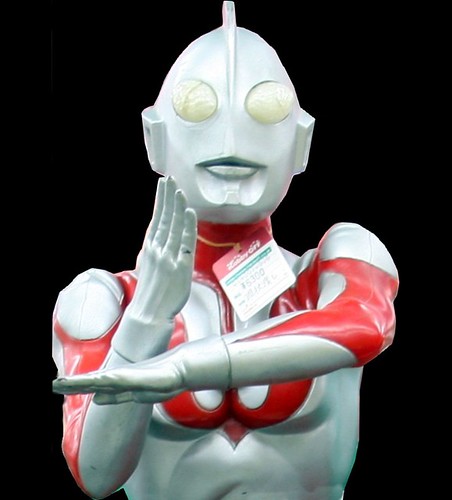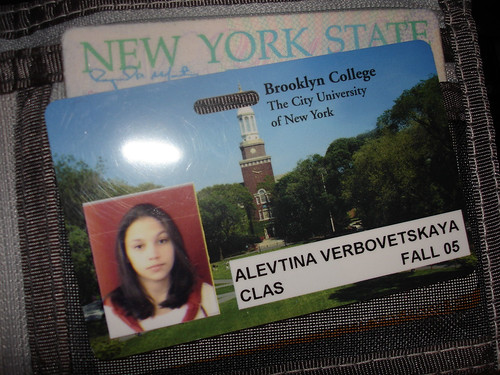Japanese Bug-Eyed-Superheroes Miming Speech
Image by timtak
It has puzzled me for a long time why so many Japanese superheroes (Ultraman, Kamen Riders, Voltron or Golion, Go-Onger, Gao-ranger, you name ‘em) have bug-eyes, unmoving mouths, or no mouth at all and have a strong connection with mime.
I now have a theory about the connection between Japanese superheroes and mime.
Japanese superheroes make many gestures (see image above), like mime artists. And more, in a sense they also speak. But their mouths are always immovable. Often they do not have mouths at all. And yet they do speak: They mime speech!
Typicaly, a group of young males and one female strike poses, press buttons, or contact someone in heaven on a magical mobile phone, and change ("hensin") into a team of superheroes wearing colour coded wetsuits. Why should then even need to change into a super hero suit? There is no secret made of their identity.
They then do stylised battle, reminiscent of badly choreographed pro-wrestling, with one or more wetsuited monsters, often with a conspicuously mobile jaw, in a car park.
As the superheroes fight they 'speak', or shout, encouraging each other. But where does their speech come from? Their mouths can not move, nor even open. They mime speech. They take out their magic mobile phones and put them to their motionless mouths. All eyes are focused toward the miming speaker.
In the mimicry of speech they are much like masked performers in the Noh Play. The body language of the players mimes speech to perfection, but the face does not move at all.
Nowhere is the mime aspect of Japanese superheroism more apparent than in the shows performed for children at Japanese festivals. Performers in bug-eye, multi-coloured mouthless wetsuits come on stage. Someone presses a button on a ghetto blaster, and off they go, miming their way through an ultra-man epic, never once saying a word, but all the while making it plain who is speaking.
The Japanese boys love it. They imitate the gestures, like the Ultraman laser beam pose above.
So why is miming speech so important?
According to Lacan the human self exists by virtue of two incomplete feedback loops: those provided by voice (or phonetic language) and vision.
We can look at ourselves in the mirror, but we can never see the minds eye. We can speak ourselves, but Lacan argues, the enunciated "I am" of my self speech, never quite coheres with the self that would be saying it.
However, with two ways back, two feedback paths, to the self, we play a shell game, or two card monte, always satisfied that when the word does not hit the mark, we can see ourselves in a mirror. And when the mirror seems empty, we can call ourselves by name.
The problem remains however, in convincing ourselves that our speech comes from the same place as our mouth. But we get used to it. Get used to thinking that sound and vision come from the same place. E.g. The people that we watch on television appear to be speaking the sounds, even though we know, if we think about it, that the sound is coming from the speakers at the side of the box.
Sound and vision never come from the same place, but we get used to thinking that they do, and the scumble that links the two together, that overcomes the contradiction of a picture that is attached to words, is paramount in the production of self.
Japanese boys watch their superheroes mime speech. They know that on the one hand their heroes are not speaking. All the people at the show, everyone knows that Ultraman is dumb, that emperor has no clothes. But the little boys also know that everyone loves the superheroes and assumes that the superheroes are speaking. They learn that if they take up the mime too, then no one will 'out them', no one will ever say "Hey, you are only miming." Superheroes and humans mime speech. It is important that they do so, and get away with it.
But why the bug eyes? For me, the bug-eyes of Japanese superheroes are seen but unseeing eyes. Their eyes are massive. Sometimes the Japanese superheroes face is all eye (Kamen rider Faizu/555). But they have no pupils, no in-eye movement to suggest that they see. Their massive eyes emphasise their visuality, but with their lack of inner eye detail, it is though they can not see at all. These eyes are, I suggest, the eyes that stare at us from out of the mirror. Our eyes as reflected mirrors fascinate us, they draw our gaze, we attempt even to look into them, but we know that they are sightless.
As I have argued elsewhere, the Japanese are permanently in "the mirror stage" in that, by virtue of their training in and ability to take multiple visual perspectives upon themselves, they continue to identify with self as reflected. Growing up in an world of uninterrupted and loving gazes, mirror identification presents little problem for the Japanese. But in order to develope a self they must also integrate the voice, attach those vocal symbols to this reflection, and hence all this heroic speech-miming.
Something similar should be going on in the West: there should be some attempt to link phoneme and imago being made. But in the West it is the identification with speech that is less fraught. So someone Western, admirable, and heroic should be 'speaking mime' rather than miming speech. I guess that this has something to do with the secret identities of Western Superheros, but for the time being, I don't know what "speaking mime" is.
Addendum. please see the next photo in my photostream. I think that "speaking mime" (the Western equivalent to the mimed speech we see Japanese superheros perform) is all the thought bubbles that we are able to see in Western superhero comics, and all the "hard boiled," coming-from-no-where, narrative that accompanies Western detective movies especially. In the West, the narrative pervades, it is the centre, the truth of the secret identity.
I think, therefore I am Batman.
Tonterías
Image by raulmahon
Autorretrato. Yo soy el de atrás. /
Self-portrait. I am behind.
Raúl González, All Rights Reserved 2008.
Tonterías by Raúl González is licensed under a Creative Commons Reconocimiento-NoComercial-SinObraDerivada 3.0 Unported License.
Amos Humiston" "Whose Father Was He?"
Image by elycefeliz
"If I ever live to get home you will not complain of being lonesome again or of sleeping cold for I will lay as close to you as the bark of a tree."
~ Letter of Amos Humiston to his wife, January 2, 1863
Amos Humiston was killed in action during the American Civil War on the Gettysburg Battlefield, July 1863, dying with his childrens' image that his wife had mailed to him months earlier.
A local girl found the image, and Dr. J. Francis Bournes saw it at a tavern and subsequently promoted the image: "wounded, he had laid himself down to die. In his hands…was an ambrotype containing the portraits of three small children… [It is] desired that all papers in the country will draw attention [so] the family…may come into possession of it" (The Philadelphia Inquirer, October 19, 1863).
Humiston's wife in Portville, New York--who hadn't received a letter from her husband since the Battle of Gettysburg--responded to the photograph description in the American Presbyterian of October 29. She subsequently confirmed the image after Bourns sent her a carte de visite copy of the image. The image identification, as well as Bourns' project for an orphans' home at Gettysburg, were publicized.
The family subsequently resided at the "National Homestead at Gettysburg" (opened October 1866) for 3 years until the widow remarried, when they relocated to Massachusetts.
Whose Father Was He?
by Errol Morris
The soldier’s body was found near the center of Gettysburg with no identification — no regimental numbers on his cap, no corps badge on his jacket, no letters, no diary. Nothing save for an ambrotype (an early type of photograph popular in the late 1850s and 1860s) of three small children clutched in his hand. Within a few days the ambrotype came into the possession of Benjamin Schriver, a tavern keeper in the small town of Graeffenburg, about 13 miles west of Gettysburg. The details of how Schriver came into possession of the ambrotype have been lost to history. But the rest of the story survives, a story in which this photograph of three small children was used for both good and wicked purposes.
Four men on their way to Gettysburg were forced to stop at Schriver’s Tavern when their wagon broke down. They heard the tale of the fallen soldier and saw the photograph of the children. One of them, Dr. J. Francis Bourns, a Philadelphia physician on his way to tend to the wounded from the battlefield, was intrigued. He convinced Schriver to give him the photograph so that he might attempt to locate the dead man’s family. Perhaps he was touched by the poignancy of the photograph — three children, all under the age of ten, now without a father. As a life-long bachelor he might have yearned for a wife or family of his own. On the other hand, perhaps he saw it as an opportunity for financial gain.
Dr. Bourns returned to Philadelphia with the ambrotype. He had it copied by several photographers, producing hundreds of inexpensive duplicates in the carte de visite format. The carte de visite photograph, roughly the size of an index card, could be printed in multiple copies, allowing for much quicker mass production of a single photographic image than ever before. Because there was no way of printing photographs in a newspaper, Bourns knew that he might need dozens if not hundreds of cartes de visite to put the image of the three children before the eyes of someone who knew them.
But the story had to be circulated as well, so the photographs were supplemented by a series of newspaper articles, the most prominent of which appeared in The Philadelphia Inquirer on Oct. 19, 1863, a little over three months following the discovery of the ambrotype. It appeared under the heading, “Whose Father Was He?”
BEST OF THE MARINE CORPS - May 2006 - Defense Visual Information Center
Image by expertinfantry
In Fallujah, Iraq (IRQ), an interpreter checks names on Humanitarian Assistance Payment slips, matching the name on each individual's identification card, in order for them to receive a one-time condolence payment of 0. The 4th Civil Affairs Group is visiting Brahma Ranch where these payments are made, in support of Operation IRAQI FREEDOM.
Learn More
Follow on Twitter
Learn More
Follow on Twitter
New ID
Image by allie™
Look! New ID! And it only cost me !
...Dang. That's five bucks I really couldn't spare :\
(Go here to read full story.)
No comments:
Post a Comment